How to Prevent and Relieve Tight or Sore Calves
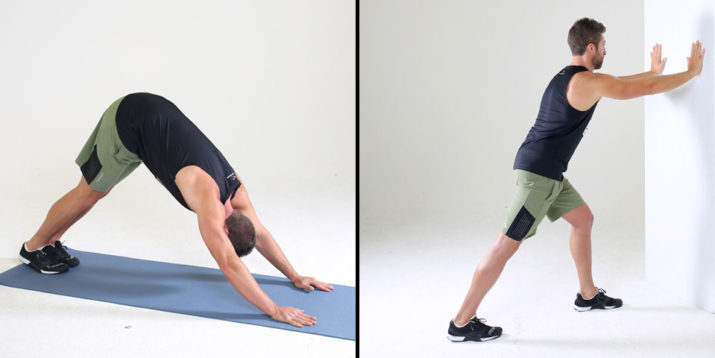
If you’ve ever done an extra hard leg workout or spent the night out in stilettos, chances are you’ve woken up the next day with sore calf muscles.
Since chronic tightness is usually caused by repetitive movement, simply doing a few stretches or getting a massage won’t permanently loosen tight calf muscles or prevent sore calves.
“In order to fix the way our bodies function, we have to improve our movements and habits,” says Cody Braun, C.S.C.S.
To prevent sore calves, start by limiting your time wearing high heels.
And understand that if you play sports that require you to be on your toes or dancing, your calves will need some extra attention.
“Then, you want to actively strengthen the opposing muscles [in your lower legs], which have not worked to their full potential due to the opposing limitations,” Braun says.
Without going too deep into calf anatomy, he suggests strengthening your anterior tibialis (the muscle that runs along your shin) and your posterior tibialis (the muscle in the arch of your foot).
Strengthening these muscles will help your body to move more efficiently.
And don’t forget your warm-up: “Foam rolling prior to exercise can help prepare the muscles to move through their proper ranges of motion,” says Alison Roessler, a personal trainer based in Oakland, California.
You should also do dynamic stretches before your workout to warm up your entire lower body, Braun explains.
By doing dynamic stretches (like lunges, leg swings, and half squats) you’ll get your whole lower body ready to work.
How to Relieve Sore Calves
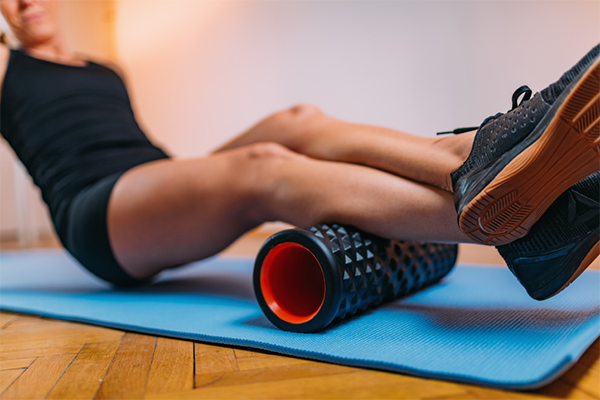
You can get achy lower legs for a number reasons.
You might find that you get tight calves after exercising, or you might get sore calf muscles from walking on new terrain (like the beach).
Whatever the culprit is for your soreness or tightness, here are a few tips to help you relieve sore calves right away.
1. Ice
Ice your muscles after a workout to help reduce inflammation, Braun suggests. You don’t need to visit a cryotherapy clinic or fill your entire bathtub with ice.
An ice pack (or bag of frozen peas) wrapped in a towel will work just fine.
2. Massage and myofascial release
Splurging on a massage from a certified therapist is another way to help with post-workout soreness.
Or, for a less expensive option, invest in a foam roller for some self-myofascial release. Rolling out your calves can improve recovery time and ease tension in muscle tissue, Braun explains.
A tennis or lacrosse ball can work well for smaller muscles like the calves, too.
3. Hydration and nutrition
What you eat and drink can play a huge role in how all of your muscles feel, calves included. Drinking enough water can help prevent cramps and muscle spasms.
Our rule of thumb is to drink half your body weight in ounces daily.
Additionally, having balanced levels of electrolytes (such as sodium, potassium, calcium, and magnesium), can help prevent calf soreness.
What you eat after a workout can also influence your post-workout muscle recovery.
“Making sure to refuel after working out (ideally within 30 minutes) with a protein and carb combo can give the muscles what they need to repair and recover faster,” Braun says.
That might include Beachbody Performance Recover, which contains 20 grams of protein per serving to support muscle growth and pomegranate extract to help fight exercise-induced muscle soreness.
4 Calf Stretches to Prevent Soreness
There are plenty of stretches for sore calves that can provide relief. Before a workout, you should opt for dynamic stretches that warm up your entire body, including your calves.
Save the static stretching (aka longer holds) for your cooldown.
You should stretch your calves specifically, and if you suspect that the tightness or soreness is linked to other areas, add stretches for those muscles, too.
Here are some stretches for tight calves that you can integrate into your regular routine.
1. Downward dog
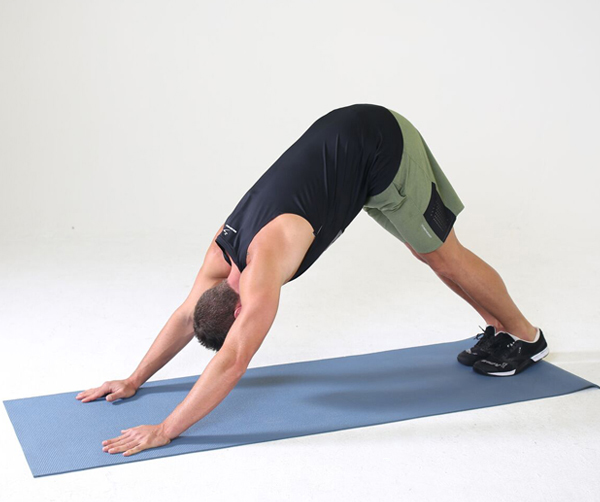
Benefits: This yoga pose is a wonderful calf stretch. Pedal out the feet, lifting one heel at a time, to stretch deeper into the calves.
- Start in tabletop, with hands on the ground under your shoulders and knees under hips.
- Push into your hands, spreading fingers wide, tuck your toes, then lift your knees as you lift your hips up.
- Straighten your legs until your body makes a triangle with the mat.
- Keep the core strong and engaged as you lengthen the spine, keeping the hips as high as you can, and pressing the heels to the floor to fully stretch the calves.
2. Straight-leg calf stretch against wall
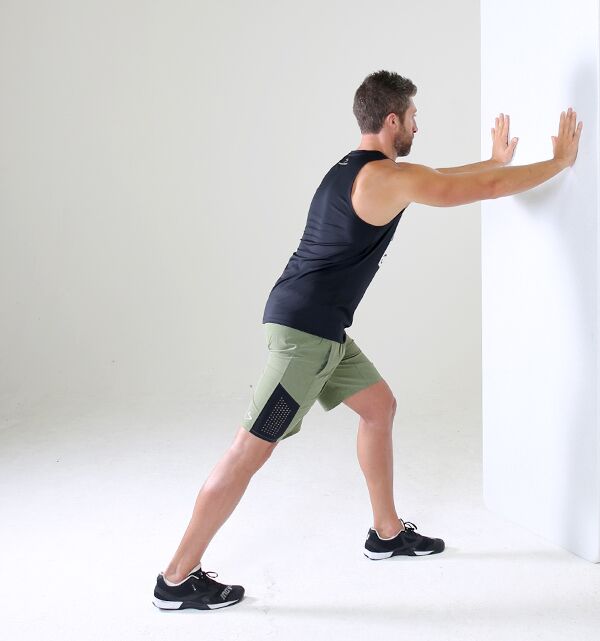
Benefits: This stretch targets your gastrocnemius and increases ankle flexibility.
- Stand an arm’s distance away from the wall. Step one foot back and bend the front knee slightly.
- Push your hands into the wall, as you lower your back, heel down. Keep your leg straight.
- Switch legs and repeat.
- To emphasize the soleus, bend your back leg slightly.
3. Standing wall calf stretch
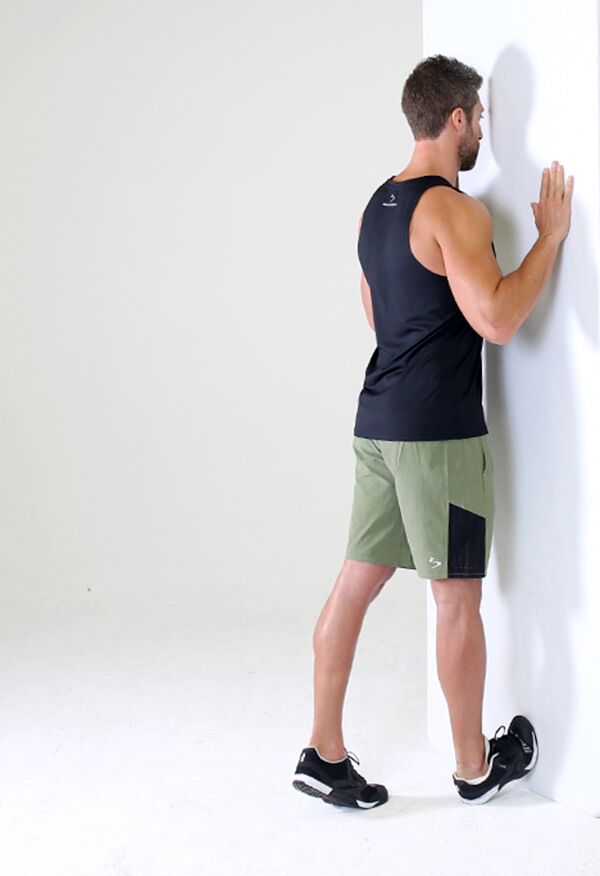
Benefits: This stretch targets your gastrocnemius and may relieve tension in your Achilles tendon and plantar fascia.
- Stand in front of a wall.
- Step one foot forward so that the ball of the foot is on the wall but the heel is on the ground.
- Place your hands on the wall as you begin to gently straighten the front leg.
- Lean forward until you feel a deep stretch in your calf.
- Switch legs and repeat.
Bonus: Calf rolling on a foam roller
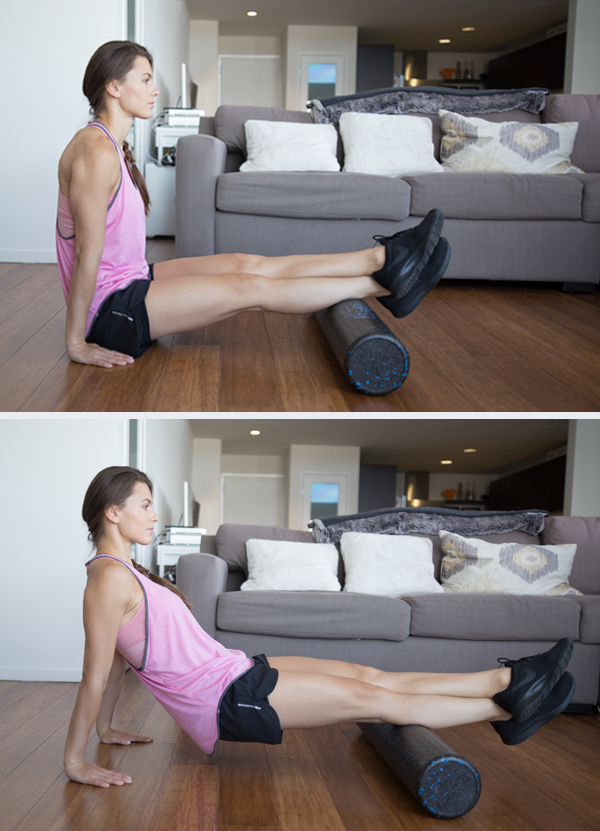
Benefits: Although this isn’t a stretch, this foam-rolling exercise can help relieve tension in the calves through myofascial release.
- While seated on the floor, place the foam roller under your right ankle. Keep your foot flexed and the toes pointing up.
- Cross your left ankle on top.
- Press your hands on either side of your hips. Lift your hips and slowly roll your lower leg over the roller from the ankle to the knee.
- After a couple of rolls up and back, repeat with the leg rotated in to target the inside of the calf. Then repeat with the toes turned out.
- If you find a tender spot, pause there for at least 30 seconds, resting your weight on the roller until the tightness releases.
Calf Anatomy
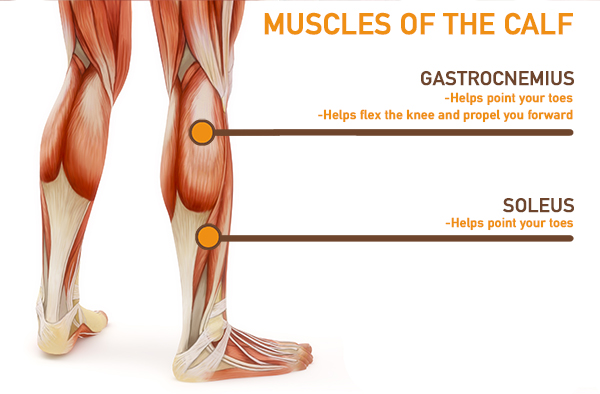
To understand why your calves are sore and how to relieve them, it’s helpful to know what muscles make up your lower leg.
The calf is made up of two muscles: the gastrocnemius and the soleus.
The gastrocnemius is the bigger of the two — it bulges out just below the back of the knee.
The soleus is located deep beneath the gastrocnemius, so it’s not outwardly visible. When either muscle is sore, the lower leg can feel sluggish and heavy.
Both calf muscles work together to point your toes, and the gastrocnemius also works with the hamstrings to flex the knee and propel you forward when you walk.
The calf muscles are connected to the Achilles tendon (which attaches to the heel bone), femur, and the shin bones.
Unsurprisingly then, people with tight calves often get Achilles tendonitis and plantar fasciitis (heel pain), says Cary Raffle, a certified personal trainer and orthopedic exercise specialist.
What Causes Sore Calves?
You can get sore calves many ways, by doing everything from dedicated workouts to lighter activity.
Chronically tight calves usually arise from repetitive movement patterns, Braun explains, whereas acutely sore calf muscles can be traced back to a single workout or specific event, like dancing all night in Vegas in 4-inch heels.
1. Exercise
If you’re an active person, your source of sore calves is probably delayed-onset muscle soreness (DOMS), caused by intense activity.
DOMS tends to peak a day after your workout, lasting up to 48 hours. “Sore calves generally come from overuse, muscle strains, inflammation, or compensations,” Braun says.
The activities that may cause sore calves usually involve spending a lot of time on the balls of the feet.
Think: running stairs, jump rope, box jumps, jump squats, calf raises, and dancing.
2. Unsupportive shoes
If you haven’t been hitting the gym and feel like you have sore calves for no reason, you may just be wearing old or unsupportive shoes.
Raffle also hears complaints after people wear heels for an extended amount of time.
“You’re essentially doing an isometric contraction of the calf muscle,” he says. “If you keep that muscle in a shortened position for a length of time, it’s going to react by feeling sore and tired.”
3. Inactivity
Inactivity in general can also lead to fluid buildup in the lower legs, making it harder for your body to pump it back up to the heart.
“This can cause a swelling effect, placing pressure on the surrounding anatomy, which can create a stiff or sore effect,” Braun says.
4. Overuse
Finally, a major reason that sore calves are particularly annoying is because you use those muscles every day.
“We use our calves every time we walk, which is why it seems hard to get away from the soreness,” Braun says.
For relatively small muscles, they have big jobs: “Because your calves help to stabilize you, they do a lot of work when your body is in motion,” he adds.
And running only increases how hard the calf muscles have to work. “When you run, you use your calf muscles for propulsion, especially as the pace gets faster,” Braun says. “Sprinting can contribute to sore calves because you are going at a high intensity.”
The Bottom Line
Tight calves are painful, and they’re usually caused by exercise-induced soreness, inactivity, or poor movement patterns.
Sore calf muscle treatment may include icing your lower legs, stretching, myofascial release, and hydration — including electrolytes to prevent muscle cramps at night or during exercise.
A sore calf muscle from walking is not uncommon; we use our calves for every step we take.
That’s also why we may have sore calf muscles after running, as the calves’ workload increases the faster we run.
Stretching your calves regularly and determining the source of your calf pain can help you find relief for sore calves.
